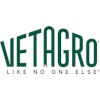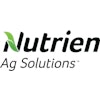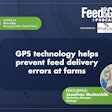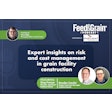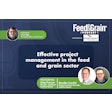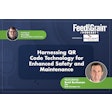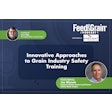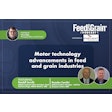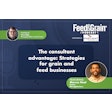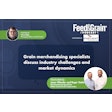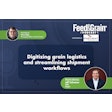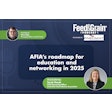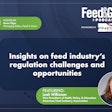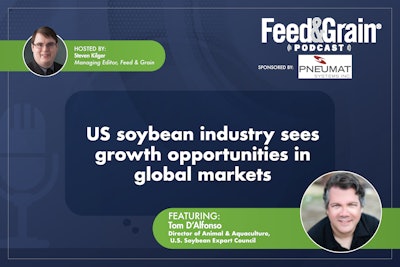
Tom D'Alfonso, director of Animal & Aquaculture for the U.S. Soybean Export Council, discusses the state of the soybean industry in this Feed & Grain podcast. D'Alfonso emphasizes the increasing global demand for animal protein, driving the need for high-quality soy in animal feed. He highlights U.S. soy farmers' commitment to sustainability and consistency, which contributes to the product's value in international markets. The podcast also explores emerging opportunities in aquaculture and the industry's focus on linking sustainability with profitability.
View on Zencastr
Steven Kilger - 00:00
Hello, my name is Steven Kilger, and I'm the managing editor of Feed & Grain Magazine and the host of the Feed & Grain Podcast. Thank you so much for joining me today as we dive deep into the issues affecting the feed manufacturing, grain handling and allied industries.
Today's episode is brought to you by the Binwhip from Pneumat Systems. The powerful dual impact Binwhip removes the toughest buildup and blockages in industrial storage silos. Without hazardous silo entry. Learn more today at binwhip.com.
Today my guest is Tom D'Alfonso, Director of Animal & Aquaculture, for the U.S. Soybean Export Council. We sat down at IPPE to talk about what's happening in the soybean export and domestic market, why U.S. soybeans are the best in the world and opportunities to expand and build the market.
I hope you enjoy the interview. If you want to help out with the podcast or listen to this in a podcasting app, please rate the U.S. and subscribe. If you're listening online. Sign up for the Feed & Grain newsletter Industry Watch to see when podcasts drop and stay up to date with news from around the industry.
Thank you for listening. And now, on to the show.
Kilger - 01:01
Hi, Tom. Thanks for joining me today.
Tom D'Alfonso - 01:02
Hi, Steven. Great to be here.
Kilger - 01:04
We're recording live from IPPE, which is always fun. But for anyone who might not know, do you mind telling me what you do with the industry? What is your place?
D’Alfonso - 01:14
Absolutely. I'm the worldwide Director of Animal & Aquaculture for the U.S. Soybean Export Council. We're here at IPPE. It's my 35th year coming before it was even called IPPE. It was the Southern Poultry Society's scientific meetings, and I'm just excited to be here. It's always a great way to start off the year with this show in January.
Kilger - 01:33
It's, I thought I was bad at 11 years, 35 before it even became co-mingled.
Let's just talk a little bit about the world of soy. What's going on? How was 2024 for U.S. soybean farmers, especially when it comes to our export markets and things like that?
D’Alfonso - 01:53
It's a very exciting time. There's a couple of big dynamics going on. The first is that the U.S. is crushing more of their own soybeans to produce oil for biofuels and to feed the growing industries of animal production and human food consumption in the United States. But for the export, it's so exciting.
The world is seeing more animal protein being consumed. That growth is really driving the need for high-quality ingredients in animal feed. Those are trends that are going to continue, and soy is the most important ingredient in an animal diet.
Kilger - 02:24
Oh yeah, it seems like everyone, and their mother is building a U.S. soybean crush and aviation fuel refinery. But I might be a little biased, but the U.S. does produce the best soybeans in the world, I think. So, the fact that there is a market out there for it, for all these other countries who are starting to see the value of it. Can you talk a little bit about your guys' work promoting that value to the rest of the world?
D’Alfonso - 02:46
Absolutely, and I always like starting the story with a U.S. soy farmer. These are family-owned farms that have been in the family business for generations. And when we talk about sustainability and quality, it really comes down to the business benefit of practicing sustainable farming in the United States.
For example, using variable amounts of inputs to the soil like fertilizer is a cost savings because you only use it where it's needed, but it also makes the farm more uniform. In the production of soy and its quality. And one of the big value drivers of U.S. soy is the consistency of the nutrient composition. That comes from the sustainable farming practices, harvesting, and the supply chain that create a high consistent, high-quality product.
Kilger - 03:33
And we're lucky enough to have such a big area where we can grow soybeans too.
So even if one area is hit by drought or flood or whatever, a lot of other places that kind of pick up the slack.
D’Alfonso - 03:50
Correct and I think part of that speaks to the resiliency. So for example, rivers, roads, and railways. We have an infrastructure that gets the soy to the market around the world.
Kilger - 03:57
Yeah and how do you feel the transportation network is holding up now? With increased quality and increased speed output for all our facilities, how is our transportation network really holding up?
D’Alfonso - 04:16
It is very resilient, and one of the benefits of U.S. soy is that we move large quantities. So on rivers and railways, roadways, we're able to transport large quantities, so there's just less damage, less touching, let's say, of the material before it gets to market.
We don't need to mechanically dry the beans, so the damage is very low, there's no incidence of heat damage that we see in other parts of the world where they need to dry the beans And so whenever you're thinking about the supply chain, you think about the quality of the product from dirt to dinner, and U.S. soy delivers value at every step of the way.
Kilger - 04:51
Once again, I might be a little biased working for a magazine that covers the grain handling industry, but I do think we have some of the best networks of elevators and handlers across the country. And we also have just a unique climate that we're able to produce so much soy and you don't really have to worry about all that, drying, and other things that are both at cost and also risk damage.
D’Alfonso - 05:13
Oh, absolutely. We're able to produce more soybeans every year without increasing our land use. And to me, that's a tremendous benefit, but also it speaks to the quality and the knowledge that goes into farming and the logistics, and the transportation systems are able to increase every year.
Kilger - 05:31
Yeah. So what are the big struggles we're seeing with soybean farmers? What do they want from their system that we're not fully managing yet?
D’Alfonso - 05:40
One of the greatest joys I have in my work is seeing the U.S. soy farmer go to other parts of the world and connect with the world in this way. And when you have such a high-quality product and you're producing a sustainable, highly nutritious, highly consistent product, you want to see markets open.
And so one of the challenges, I think, is making sure the doors are open. And that speaks to our relationship-building and our understanding of the global market, sometimes the door closes in one place and opens in another. And what we would like to see is the market for U.S. soy, the doors being open, and this is something that is a benefit when we're able to go and influence the government regulators, and consumers. And to understand that the world benefits from U.S. soy feeding the animal production systems all over the world. So one of the challenges is making sure those doors are open.
Kilger - 06:36
It's a process. That's what makes your association so important, makes the U.S. Grains Council so important and so many others, is it's a long-term effort. It's not as simple as being like, hey, buy our beans.
D’Alfonso - 06:50
It takes a long time to build trust. Trust is something we hear from our target audiences all the time, that they trust the U.S as a source of information about science and the supply chain and the markets. And we think those relationships that we build all over the world, as important as the quality of the product.
Kilger - 07:05
Like you said, the product's there, the reliability is there, and it's really just getting that message out to the world, especially, since we all know you can always buy the cheapest option.
D’Alfonso - 07:14
Well, pay me now or pay me later. Exactly. We see, and in fact, I want to speak to that because we see the damage that is done by ... feeding less quality soy and animal diets.
The diets are more costly to meet the nutrient requirements the animals don't grow as well, or they're not as uniform when they get to the processing plant. And when you're looking at quality, price is always a factor, but you have to look at the value and the profitability of your operation. And that's where we really excel in demonstrating that superior quality brings payback to the animal producers.
Kilger - 07:50
Yeah, and the safety week managed to achieve alone the entire value chain in the farmer all the way to when it gets to your export destination. So what are you guys working on in 2025? It's obviously a big year for soybean exports in general of everything. What are you kind of going into 2025?
D’Alfonso - 08:10
There's a lot of things coming together in 2025. We're really focused on the profitability of our end-user customers of U.S. soy. We're able to tie together sustainability with their profitability. For example, we're finding that poultry producers and aquaculture producers are labeling their products as having been fed with sustainable U.S. soy. This creates new markets for their products.
It's very exciting to see, for example, aquaculture. This industry is transformational. There are very few industries that are transformational, to tell you the truth. We may think of things like artificial intelligence and big data, but that's been around since the 1950s and 1960s.
In just the last 10 years, we've gone from a situation where most of the seafood was caught in the wild to now ... We are feeding fish sustainably in systems that are profitable and reliable. And this is truly transformational.
Now, most of the seafood that we consume is fed and produced in aquaculture production systems. We're playing a big role in understanding not just the nutrition of animals that weren't really fed before but also the production systems to produce soy-optimized feeding systems for the aquaculture production systems around the world.
Kilger - 09:24
Yeah, aqua vulture is one of those industries that I feel just is a no-brainer. There are probably people out there who don't like it for whatever reason, but it is safer, and sustainable for our oceans.
My cat personally only likes real tuna-flavored stuff. So I had to look up like, can I feed them this every day without giving him mercury poisoning? And that's something you could do because we have an aquaculture system.
D’Alfonso - 09:50
We're monitoring the health and the performance of the animals we feed, whether it's fish or chickens all over the world, and we're seeing the benefits to the animal health and performance because of feeding U.S. soy in these systems.
Kilger - 10:02
And is that a big area of growth you're expecting over the next couple of years?
D’Alfonso - 10:05
The aquaculture sector is a very big growth area. And I think the other is our understanding of the health benefits of soy in human and animal diets. Just wonderful compounds like isoflavones and anti-inflammatory and immune regulation are all benefiting from having soy in our diet as humans or in animals. And so we're really turning the science into profitability for our end users.
Kilger - 10:29
Right. Anything else you would like our readers to know about?
D’Alfonso - 10:34
I can't say too much about how I think it all comes back to the U.S. soy farmer. I think when people think of American agriculture, they may think of big industries and so forth. But really, the soy industry comes from family-owned farms that are passed down from generation to generation.
More than 90 percent of soy comes from the family farm. And for them, sustainability is business sustainability. Practices of things like the variable application of inputs and the other sustainability practices turn into value downstream. And so we're tying together the value across the supply chain.
We're talking to growers, we're talking to our partners in logistics and the supply chain, to the traders, the nutritionists, the feed mill managers, the animal production systems, and we're asking them what value is U.S Soy in your business? And we're hearing that it is a very important part of the profitability of their operation and that the consistency, and the quality are what they expect and they see in U.S Soy.
Kilger - 11:32
Sustainability is obviously another big issue for the entire value chain. It has been nice to see more and more companies and government programs, all encouraging soybean farmers to adopt sustainable practices, which is good for everybody. I never met producers who don't care if my soil can last to the next generation. They all want to do it. They all want to produce better. They just also want to be profitable.
D’Alfonso - 11:57
The other thing I noticed in the past couple of years was I thought it was the consumers who were driving the sustainability movement. The consumers, of course, want their food to be produced in a sustainable manner. But when given the option to choose between two products, the price doesn't matter. And what we're finding is it's the financial institutions that are driving sustainability because they know that companies that adopt sustainable practices are applying practices that are going to keep their business profitable. So sustainability and profitability really go hand in hand.
Kilger - 12:30
That is the most important thing, which is the consistency of our product. If that is our selling point, it's important that we make sure that our farms last and our environment is clean and good, and all these things are benefits to everyone. So it's really nice to see those programs being adopted and being put out there.
D’Alfonso - 12:47
Absolutely, Steven.
Kilger - 12:48
If people want to know more information, want to get involved, want to learn more, where should they go?
D’Alfonso - 12:53
Look U.S up online at USSEC.org and you'll find a lot of information. Our customers say that we are a trusted source of knowledge in not just soy production, but in the animal production industries. And please come and visit our site or contact any one of us around the world.
Kilger - 13:08
Which I will also attest to. I love it when you guys send out a press release, with our information. We eat it up in our magazines. So the entire industry should really be keeping an eye on what you guys are doing.
Kilger - 13:22
And thank you so much again for agreeing to talk to me today. I really enjoyed it. I hope I can have you on again.
D’Alfonso - 13:27
I'd be happy to.
Kilger - 13:28
Maybe in a quieter setting.
D’Alfonso - 13:30
The place is buzzing. And I love that actually about this event.
Kilger - 13:33
It is awesome. All right. Thank you so much.
.jpg?auto=format%2Ccompress&crop=faces&fit=crop&h=48&q=70&w=48)
